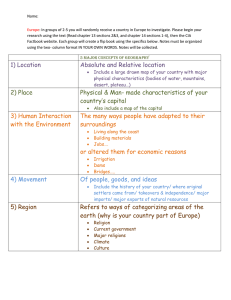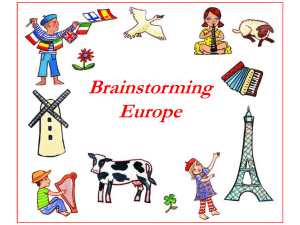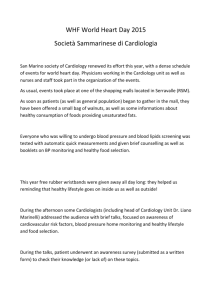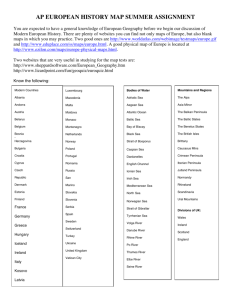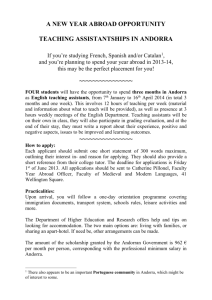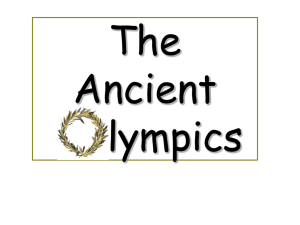Ch. 21: Southern Europe
advertisement
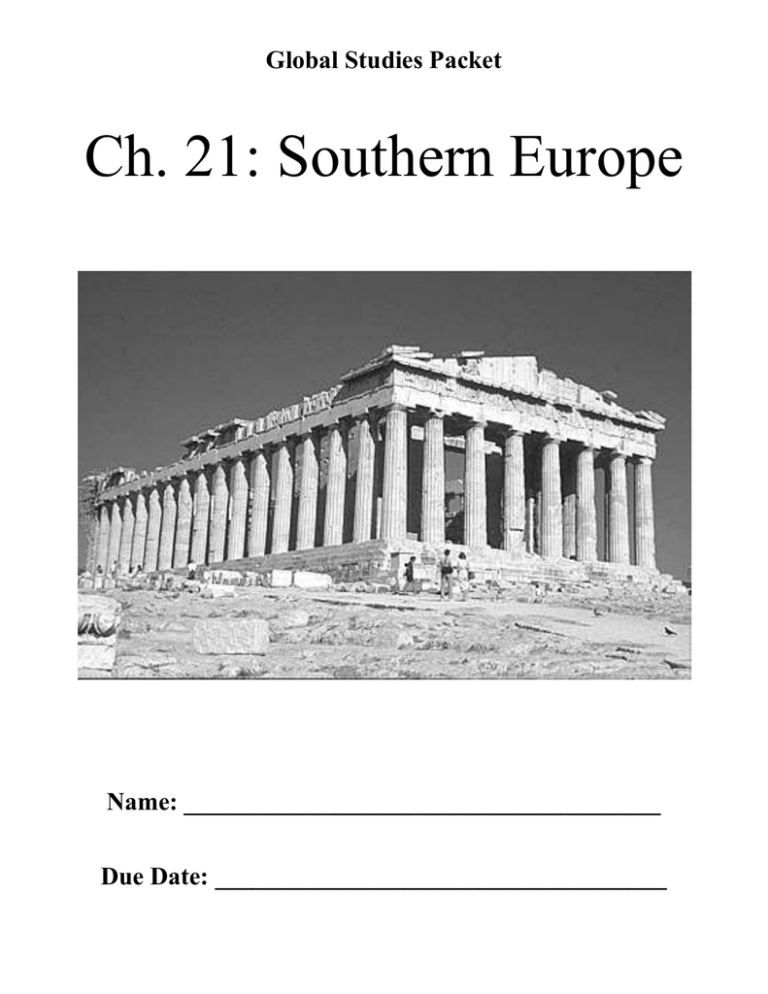
Global Studies Packet Ch. 21: Southern Europe Name: ______________________________________ Due Date: ____________________________________ Vocabulary Use page 301 of the textbook to complete the exercise below. Term CLASS WORK Definition Picture PAGE 1 Western Europe Map Use the numbers to locate each country on the map. Use atlas pp. 66-67 or textbook pp. xxviii. 1. Andorra 2. Austria 3. Belgium 4. Denmark 5. France 6. Finland 7. Germany 8. Greece 9. Iceland 10. Ireland 11. Italy 12. Liechtenstein 13. Luxembourg 14. Malta 15. Monaco 16. Netherlands 17. Norway 18. Portugal 19. San Marino 20. Spain 21. Sweden 22. Switzerland 23. United Kingdom 24. Vatican City Identify the capitals of the following countries: CLASS WORK ___________________, Greece ___________________, Italy ___________________, Portugal ___________________, Spain PAGE 2 Gifts from Ancient Times Use textbook pages 304-305 to answer the questions in complete sentences. 1. What are the main gifts that the Greeks gave to the modern world? 2. In the context of this section, what does drama mean? 3. What developed out of the Greek idea that natural forces rather than spirits cause disease? 4. What were two problems with Greek democracy? 5. What is Rome’s main contribution to modern life? 6. The legal system of every Western country is partially based on Roman law. Why do we need laws? How do you think people acted before Roman law? Be sure to answer both parts of the question in complete sentences. Match the contribution to Western culture with Greece or Rome. G = Greece _____aqueducts _____science of plumbing _____roads and bridges _____drama _____stories and ideas _____system of law _____Iliad and The Odyssey _____philosophy _____modern medicine _____democracy CLASS WORK R = Rome PAGE 3 The Olympic Games Use this reading to answer the questions on the following page. Today, people around the world thrill to the arrival of the Summer Olympic Games every four years- an international sports competition involving events from boxing to basketball. Falling halfway between the Summer Olympics are the Winter Olympics, featuring skiing events, skating competitions, and snowboarding. The spirit of these biannual athletic contests began on the Greek Peloponnesus in the year 776 B.C. Although the original Greek Olympic Games were very different from today's extended international games, the competition was keen. Even when the various city-states were in conflict or at war, every four years they sent their best athletes to Olympia along the banks of the Alpheus River on the Peloponnesus. At the 776 B.C. Olympics, the people of Elis (the Eleans), who lived on the level plains near Olympia, held a foot race of about 200 yards to honor their god, Zeus. As other Olympics were held, other city-states sent their athletes to compete in the races. By 708 B.C., the games included not only foot races, but jumping, discus throwing, wrestling, and javelin throwing. Later games included boxing and chariot racing. As many as 50,000 Greeks might gather at the games as spectators, cheering for the athletes from their city-state with patriotic pride. The games were scheduled during the months of August or September. By then, farmers had brought in their annual harvest and were free to attend the games. But the season is a hot one and the athletes competed in burning heat. Perhaps this is why the athletes generally performed in the nude, covering their bodies with oil. Typically, Greek Olympic Games lasted five days, with the first day marking the opening of the events by a sacrifice to Zeus. During this ritual, athletes swore to compete honestly and not to cheat. Judges vowed to be fair, as well. The second day featured chariot races, which might pit as many as 40 chariots against one another. Other events held on the second day included a pentathlon, consisting of running, long jumping, discus throwing, javelin throwing, and wrestling. Long jumpers held lead or stone weights when jumping, which they swung forward to help carry them farther through the air. One brutal event at the games was pankration, a no-holds-barred combat with only two rules: no biting and no eye-gouging. Foot races were held on the third and fourth days, as well as boxing and wrestling. The foot races were eventually held in a stadium measuring 218 yards long with a sand-covered field. On the fifth day, the winning athletes received prizes which included a great banquet and a wreath of wild olive cut from the sacred trees outside the temple of Zeus. Other prizes might include exemption from taxes and honor at home. CLASS WORK PAGE 4 The Olympic Games Answer these questions in complete sentences. 1. Describe the Olympics. (What are they? How often are they held? What are the two main types of Olympics?) 2. Describe the first Olympics. (When were they held? Which city held them? What competition did they include? Who did they honor?) 3. What types of athletic competitions did the Greek Olympics include? (Be sure to mention at least 5.) 4. Describe the prizes that the winners received. (Be sure to include 3 things.) CLASS WORK PAGE 5 Venn Diagrams: Micro-Countries Use the readings to fill in the chart and the venn diagram on the next page. Andorra Andorra was born in 988 when it received a charter from Charles the Great (Charlemagne) in return for fighting against the Moors. It is a monarchy headed by two Co-Princes – the Spanish Roman Catholic Bishop of Urgell and the President of France. Andorra is a prosperous country mainly because of its tourism industry. It is not a member of the European Union, but the euro is the commonly used currency. The official language is Catalan, although Spanish, French, and Portuguese are also commonly spoken. Andorra consists predominantly of rugged mountains. San Marino Located on the northeastern side of the Apennine Mountains, the Republic of San Marino is a microstate surrounded by Italy. San Marino started as a monastic community in 301. Over time, it became a republic. San Marino is the oldest surviving sovereign state and constitutional republic in the world. The constitution of San Marino, enacted in 1600, is the world's oldest constitution still in effect. San Marino is led by two Captains Regents who are elected every six months. The country's economy mainly relies on tourism, and San Marino's culture remains Italian. Although San Marino is not a European Union member, it is allowed to use the euro as its currency. The official language is Italian. Complete the following chart and then use this information to fill out the venn diagram on the next pare to compare and contrast Andorra and San Marino. Andorra San Marino When was the country founded? What type of government do they have? Who are their leaders? What is the primary economic activity? What is the currency? What languages are spoken? What is the geography like? CLASS WORK PAGE 6 Venn Diagrams: Micro-Countries Attributes for ONLY Andorra go in this area: Attributes for BOTH countries go in the middle. Attributes for ONLY San Marino go in this area: CLASS WORK PAGE 7 CLASS WORK PAGE 8 Smallest Nation Reading 1. In what other city and country is Vatican City located? 2. What famous piece of art is in the Vatican? 3. How many people live in Vatican City? 4. What happened to early Christians on the site where St. Peter’s Basilica now stands? Map 5. In which building does the pope live? 6. What are Vatican City’s latitude and longitude? 7. About how far is the Vatican’s farthest-north point from its farthest-south point? 8. From the museum entrance to the obelisk in St. Peter’s Square is how many straightline feet and is which direction? CLASS WORK PAGE 9 YouTube Videos: Micro-Countries Watch two of the videos, complete the chart, and then compare and contrast the two countries. Little Europe: The Vatican City http://www.youtube.com/watch?v=r3Aqx937YV0 Little Europe: Monaco http://www.youtube.com/watch?v=rHMZSCfiCrA Little Europe: Andorra http://www.youtube.com/watch?v=B10DiNXmFQM Little Europe: San Marino http://www.youtube.com/watch?v=eSqoEhWd9cM Little Europe: Liechtenstein http://www.youtube.com/watch?v=_MTVLKLze3E Micro-Country Name What is the geography like? (mountains, forest, island, seashore, city, etc.) What is something to see or do while visiting this micro-country? Give one other fact about the micro-country. Would you like to visit this micro-country? Yes or no? Explain why? Comparison What is one thing these two micro-countries have in common? Contrast What is one way that these two micro-countries are different? CLASS WORK PAGE 10 Chapter 21 Review Complete the chapter review activities on pages 312-313. Write out all answers fully! Vocabulary Review (Complete each sentence with a term from the list) 1. ______________________________________________________________________ ________________________________________________________________________ 2. ______________________________________________________________________ ________________________________________________________________________ 3. ______________________________________________________________________ ________________________________________________________________________ 4. ______________________________________________________________________ ________________________________________________________________________ 5. ______________________________________________________________________ ________________________________________________________________________ Chapter Quiz (Answer in complete sentences. Include the question in your answer.) 1. ______________________________________________________________________ ________________________________________________________________________ __________________________________________________________________(p.302) 2. ______________________________________________________________________ ________________________________________________________________________ _________________________________________________________________(p. 302) HOMEWORK PAGE 11 3. ______________________________________________________________________ ________________________________________________________________________ _________________________________________________________________(p. 309) 4. ______________________________________________________________________ ________________________________________________________________________ _________________________________________________________________(p. 305) 5. ______________________________________________________________________ ________________________________________________________________________ _____________________________________________________________(pp. 308-309) HOMEWORK PAGE 12 Textbook Questions Use the textbook to answer the questions in complete sentences. Countries of the Mediterranean (pp. 302-303) Use complete sentences. 1. Describe the climate of the Mediterranean. 2. What has been threatening the fishing industry in the Mediterranean? 3. Why isn’t Greece considered part of Eastern Europe? 4. Would you want to visit Southern Europe? Why or why not? Roman Catholicism and the Vatican (pp. 306-307) Use complete sentences for #1 & 3. 1. What is the only Southern European country that is not a Catholic country? 2. Despite having only about 1,000 citizens, Vatican City has its own _____________, a _________________, and its own ____________________. 3. Generally, what are two differences between the Orthodox and Catholic Church? HOMEWORK PAGE 13 Greece and Rome Review Refer to pages 304-305 to complete the activities below. HOMEWORK PAGE 14 Ch. 21 Study Guide Each Friday, we will have a quiz on the week’s packet. The most important things to know are on this study guide. 1. Vocabulary a. define the terms, use them in sentences, and give examples 2. Western Europe Map a. match countries with their locations (a practice powerpoint is on Mr. Nolen’s website) b. identify the capitals of Greece, Italy, Portugal, and Spain 3. Gifts from Ancient Times a. match contributions to Western society with either Greece or Rome 4. The Olympic Games a. describe the Olympics 5. Micro-Countries a. describe one or two micro-countries 6. Chapter Quiz a. describe what a Mediterranean climate is like 7. Textbook Questions: Roman Catholicism and the Vatican a. identify which Southern European country is not a Catholic country STUDY GUIDE PAGE 15
